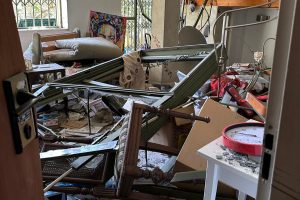TORONTO — A new gallery featuring more than 1,000 objects from the Middle East, including a Sephardi Torah donated by the late Ed Mirvish, opened recently at the Royal Ontario Museum (ROM).
A Torah scroll and cover |
The Wirth Gallery of the Middle East, named in honour of philanthropist, financier and longtime ROM supporter Alfred Wirth, features objects from Afghanistan, Egypt, Iran, Iraq, Israel, Jordan, Lebanon, the West Bank, Syria, Turkey and Yemen, dating from the Paleolithic Age to 1900.
On Level 3 of the Michael Lee-Chin Crystal are clusters of artifacts arranged by themes: Arms and Armour, Arts in Life, Documents and Writing, Technology, and Ancient Spirituality and Religion. The last is an exploration of religious practices of the Jewish, Christian and Islamic religions seen through burial items and religious objects.
“The Middle East collection used to be on the third floor centre block in a rather dark area, in the catacombs almost,” said William Thorsell, the ROM’s director and CEO. “We opened it up and increased the diversity and volume of the collections. Many pieces were largely stranded in the ROM’s storage rooms in the 1920s without a permanent home, so it was quite moving to see the carts coming up with artifacts from core religions.”
Entering the Middle East Gallery you’ll find burial objects: three Jewish ossuaries (stone boxes) from the Herodian period, circa 100 BCE-100 CE, with gabled lids made of limestone, painted and inscribed with six pointed rosette decorations.
“The circular markings [rosettes] on the ossuaries made with a compass are the simplest way of decorating – the symmetry is visible and the esthetics have continuity,” said Krzysztof Ciuk, assistant curator of Islamic history and archeology at the ROM. “Some scholars interpret it as a religious symbol suggesting the [rosettes] predate the star, but the star is not exclusive to Judaism. It is a very common decorative element in Islamic religion as well.”
Ossuaries containing the bones of the dead, dating back to the first century BCE in Jerusalem, reflected the belief held by some at the time that the dead will be resurrected when the Messiah comes.
Also on exhibit is a small Syrian ceramic lamp from the fourth century CE, which has a menorah on it representing the one that stood in the Temple in Jerusalem – a seven-branched candlestick. Since Palestine was multicultural, lamps for Jews and Christians were made in the same factory, but with different symbols.
Rounding out the Wirth Gallery’s impressive display is a Torah scroll with a beautiful Iraqi embossed silver case. According to the inscriptions, the case was made in 1907 to honour the memory of Ruhama, daughter of Katton, by her son, Rabbi Abraham. The scroll came from an older Torah case of the 17th-18th century.
While at the ROM, visit the Bishop White Gallery of Chinese artifacts tucked behind the central Currelly Gallery on Level 1. When the Kaifeng synagogue was destroyed by the flooding of the Yellow River in 1851, a few stone bowls and architectural pieces were salvaged. The collection includes a lovely Torah case of wood and gold lacquer dating back to the 17th century from the Qing Dynasty, a rare ink rubbing of a stone tablet engraved with the history of the synagogue from 1489 and a stone drain mouth for washing hands carved with monkeys and vines.
The Sir Christopher Ondajee South Asian Gallery opened in the Michael Lee-Chin Crystal at the same time as the Wirth Gallery. The final two permanent galleries – the Patricia Harris Gallery of Textiles and Costume and the Shreyas and Mina Ajmera Gallery of Africa, the Americas and Asia-Pacific are set to open April 5. For more information, visit www.rom.on.ca.







